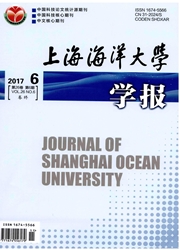

 中文摘要:
中文摘要:
2009年6-8月在长江口及杭州湾水域收集到1 355尾凤鲚(Coilia mystus)样品,取其胃含物并对其饵料组成和数量进行分析。结果表明:长江口长兴岛北港水域每尾凤鲚对桡足类摄食数量为0.10~3.31个,长江口九段沙南槽水域每尾为0.06~0.23个,因此可以认为产卵场凤鲚的摄食强度大于洄游中凤鲚的摄食强度。同时发现,每尾体长为100~150 mm的凤鲚摄食糠虾类数量在0.4个左右,而150~190mm体长组糠虾类的数量在0.1个以下。研究表明,个体较大的凤鲚并未对较大个体的糠虾类有更强的摄食趋势。同样,食物中桡足类数量分布与体长组变化也没有明显的关系。在杭州湾,凤鲚的胃含物和栖息水域中都有大量糠虾出现,而在长江口,凤鲚胃含物有零星糠虾出现,其栖息水域的采样中则没有糠虾记录。这说明栖息水域环境中饵料生物组成的差异是凤鲚饵料种类数量不同的重要原因。此外还发现,凤鲚对中华哲水蚤(Calanus sinicus)(I=0.89)和长额刺糠虾(Acanthomysis longirostris)(I=0.86)选择性较强。而凤鲚对火腿许水蚤(Schmackeria poplesia)(I=-0.39,Y=0.30)等这些栖息水域环境中的优势种类属被动摄食,不具选择性。研究亮点:目前对凤鲚食性的研究只在凤鲚生物学的叙述中提到,没有食性数量的进一步分析。对长江口及其附近水域凤鲚的食物组成及摄食习性进行分析,并将凤鲚的食物组成与栖息水域中的浮游动物种类数量组成进行比较分析。为凤鲚食性的进一步研究以及凤鲚渔业资源的保护、增殖和合理利用提供基础资料。
 英文摘要:
英文摘要:
In order to study the diet composition and quantity of Coilia mystus, 1 355 stomach samples of C. mystus collected from Yangtze River Estuary and Hangzhou Bay from June to August in 2009 were analyzed in this paper. The feeding amount of Copepoda ranged from 0.10 ind/fish to 3.31 ind/fish in North Channel, Changxing Island, Shanghai, while 0.06 - 0.23 ind/fish in South Passage, Jiuduansha Wetland, Shanghai, which indicated that the feeding intensity of C. rnystus in spawning ground was relatively higher than that during migration. It' s detected that the amount of Mysidacea was about 0.40 ind/fish in 100 - 150 mm size classes, and 0.10 ind/fish in 150 - 190 mm ones, which demonstrated that there was no obvious tendency of preying bigger Mysidacca by C. mystus in bigger size classes. Besides, the relationship between amount distribution of Copepoda and the size classes of C. mystus was not evident. Mysidacea was found both in stomachs of C. mystus and water samples collected from Hangzhou Bay, while there was a little amount of Mysidacea in C. mystus and none in water samples collected from Yangtze River Estuary. This showed that different composition of diet organism in various waters was the primary reason for the variety of C. mystus feeding components. It' s also found that C. mystus showed a preference for Calanus sinicus (I = 0.89) and Acanthomysis Iongirostris (I = 0.86 ), while C. mystus had no active selectivity for dominant species in waters, such as Schmackeria poplesia (I = - 0.39, Y = 0.30).
 同期刊论文项目
同期刊论文项目
 同项目期刊论文
同项目期刊论文
 Fatty acids and stable isotopes of a marine ecosystem: Study on the Japanese anchovy (Engraulis japo
Fatty acids and stable isotopes of a marine ecosystem: Study on the Japanese anchovy (Engraulis japo Optimal salinity for dominant copepods in the East China Sea, determined using a yield density model
Optimal salinity for dominant copepods in the East China Sea, determined using a yield density model 期刊信息
期刊信息
